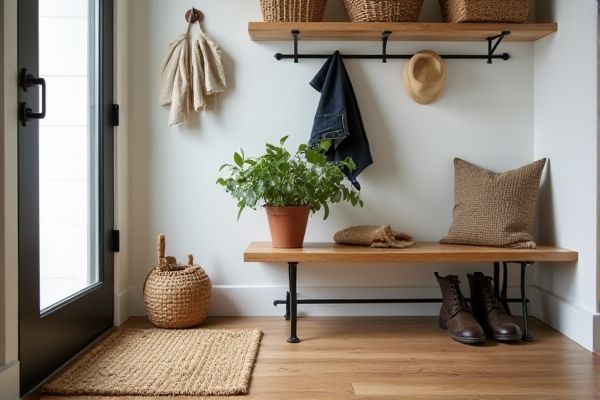
Outdoor mats are designed to withstand harsh weather conditions and effectively scrape mud, dirt, and debris from your shoes, while indoor mats in a mudroom focus on absorbing moisture and protecting flooring from stains and wear. To understand which mat suits your home's entryway needs and maintains cleanliness efficiently, explore the detailed comparisons in the rest of this article.
Table of Comparison
| Feature | Outdoor Mat | Indoor Mat (Mudroom) |
|---|---|---|
| Primary Use | Traps dirt and moisture outside entry points | Captures residual dirt and moisture inside the home |
| Material | Durable, weather-resistant materials (e.g., coir, rubber) | Softer, absorbent materials (e.g., microfiber, cotton) |
| Weather Resistance | High resistance to rain, snow, UV, temperature changes | Low to moderate resistance; designed for indoor environments |
| Cleaning | Shake off or hose down; easy to clean | Machine washable or vacuum-friendly |
| Design | Coarse texture for scraping shoes | Soft texture for comfort and absorbency |
| Size | Larger to cover wide areas outside doors | Smaller, fits mudroom or entryway spaces |
| Functionality | Prevents dirt and debris from entering home | Protects indoor flooring from moisture and tracks |
Introduction: Outdoor Mat vs Indoor Mat (Mudroom)
Outdoor mats are designed with durable, weather-resistant materials to effectively trap dirt, mud, and moisture before entering your home, making them ideal for high-traffic exterior areas. In contrast, indoor mats, especially those used in mudrooms, prioritize soft textures and absorbency to keep indoor floors clean and dry while providing comfort underfoot. Selecting the right mat type ensures optimal cleanliness and protection tailored to your specific entryway conditions.
Key Differences Between Outdoor and Indoor Mats
Outdoor mats are designed with durable, weather-resistant materials such as coir, rubber, or polypropylene to withstand moisture, dirt, and heavy foot traffic, while indoor mudroom mats prioritize softer fabrics like microfiber or cotton for comfort and absorbency. The texture of outdoor mats typically features rough, abrasive surfaces to scrape off mud and debris, contrasting with indoor mats that use plush, absorbent fibers to trap moisture and protect flooring. Placement varies as outdoor mats are installed at entrances exposed to elements, whereas indoor mudroom mats are positioned inside entryways to maintain cleanliness and dry footwear.
Material Comparison: Durability & Functionality
Outdoor mats are typically made from durable materials like coir, rubber, or polypropylene, designed to withstand harsh weather conditions and heavy foot traffic while effectively scraping dirt and moisture. Indoor mats, especially those used in mudrooms, often feature softer materials like microfiber or cotton blends that prioritize absorbency and comfort but are less resistant to abrasion and outdoor elements. The choice between outdoor and indoor mats hinges on balancing durability for exposure and functionality for moisture control and cleanliness within transitional spaces.
Weather Resistance: Which Mat Handles the Elements?
Outdoor mats are specifically designed with weather-resistant materials such as rubber, coir, or synthetic fibers that withstand rain, snow, and UV rays without deteriorating. Indoor mudroom mats, while durable, typically prioritize absorbency and dirt trapping over extreme weather resistance, making them less suitable for prolonged exposure to harsh elements. Selecting an outdoor mat ensures superior performance in withstanding moisture, freezing temperatures, and sun exposure, essential for protecting entryways against the elements.
Dirt and Moisture Absorption Capabilities
Outdoor mats excel in dirt and moisture absorption due to their coarse fibers and durable materials designed to scrape off mud, leaves, and heavy debris before entry. Indoor mudroom mats prioritize moisture absorption with highly absorbent fabrics that trap water and fine dirt, protecting interior flooring from damage and slipping hazards. Selecting mats with high-quality synthetic fibers or natural coir optimizes the balance between scraping dirt outdoors and soaking up moisture indoors.
Style and Aesthetic Considerations
Outdoor mats typically feature durable materials like coir or rubber with bold textures designed to withstand weather and heavy foot traffic, complementing rustic or rugged exterior styles. Indoor mudroom mats prioritize softness and design versatility, often made from plush or woven fabrics that enhance interior decor while providing comfort and warmth. Your choice should balance functional durability outside with aesthetic appeal inside, ensuring both areas reflect a cohesive style that suits your home's personality.
Cleaning and Maintenance Requirements
Outdoor mats, designed with durable, weather-resistant materials, effectively trap dirt and moisture, requiring regular shaking or hosing off to maintain cleanliness. Indoor mudroom mats often feature softer, absorbent fibers that capture fine dust and mud, necessitating more frequent vacuuming and occasional deep cleaning to prevent odor buildup. Choosing mats with antimicrobial properties can reduce maintenance efforts by inhibiting bacterial growth in high-traffic entryways.
Safety Features: Slip Resistance and Stability
Outdoor mats typically offer enhanced slip resistance and durability to withstand wet and muddy conditions, ensuring safety when entering your home. Indoor mats in a mudroom prioritize stability on smooth floors, often featuring non-slip backings to prevent shifting and reduce the risk of slips. Choosing the right mat for each area maximizes safety by providing traction and stability tailored to different environmental conditions.
Placement Tips for Maximum Effectiveness
Place outdoor mats at entry points exposed to dirt and moisture, such as front doors and back porches, to trap debris before it enters the home. Indoor mats in mudrooms should be positioned strategically to absorb residual moisture and dirt from shoes, protecting flooring and maintaining cleanliness. Selecting mats with textured surfaces enhances dirt removal efficiency and ensures maximum effectiveness in both settings.
Choosing the Best Mat for Your Mudroom Needs
Outdoor mats are designed with durable, weather-resistant materials that effectively trap dirt, mud, and moisture before entering your home, making them ideal for high-traffic entryways exposed to the elements. Indoor mudroom mats prioritize comfort and aesthetics with softer textures and absorbent fibers, helping to keep floors dry while complementing your interior decor. Choosing the best mat for your mudroom depends on your location, foot traffic, and whether your primary goal is protection from outdoor debris or enhancing indoor cleanliness and style.
 homyna.com
homyna.com